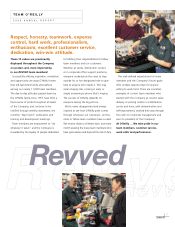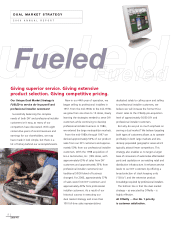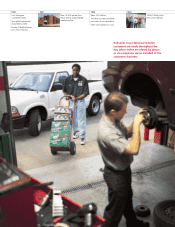O'Reilly Auto Parts 2000 Annual Report Download - page 19
Download and view the complete annual report
Please find page 19 of the 2000 O'Reilly Auto Parts annual report below. You can navigate through the pages in the report by either clicking on the pages listed below, or by using the keyword search tool below to find specific information within the annual report.
2000 AR
17
Our provision for income taxes was 37.5% and 38.4%, respectively,
of income before income taxes in 1999 and 1998. The decrease in
the effective tax rate primarily related to a higher percentage of our
sales occurring in states with lower income tax rates.
Principally as a result of the foregoing, net income in 1999 was
$45.6 million (or 6.1% of product sales), an increase of $14.9
million (or 48.3%) from net income in 1998 of $30.8 million
(or 5.0% of product sales).
Liquidity and Capital Resources
Net cash provided by operating activities was $5.8 million in 2000
and $29.7 million in 1999. Net cash used in operating activities was
$19.1 million in 1998. The decrease in cash provided by operating
activities in 2000 compared to 1999 is the result of an increase in
inventory and to a lesser extent, increases in accounts receivable
and amounts receivable from vendors, partially offset by increases
in net income, accounts payable and accrued payroll. The increase
in net cash provided by operating activities in 1999 compared to
1998 is the result of increases in net income, accrued payroll, other
current liabilities and a larger tax benefit resulting from stock
option exercises, offset by increases in amounts receivable from
vendors and inventory.
Net cash used in investing activities was $40.5 million in 2000,
$77.8 million in 1999 and $100.8 million in 1998. The decrease
in cash used in 2000 was primarily due to the sale of 90 properties
for $52 million in a sale-leaseback transaction. The decrease in
cash used in 1999 was due to the Hi/LO acquisition in 1998 and
an increase in payments received on notes receivable, partially
offset by increased purchases of property and equipment. The
increase in cash used in 1998 was primarily due to the purchase
of Hi/LO and increased capital expenditures.
$ 0
(thousands)
1999
$ 1,423
1998
$ 1,368
1997
$ 1,306
1996
$ 1,239
1995
$ 1,101
2000
$ 1,412
$ 250
$ 500
$ 750
$ 1,000
$ 1,250
$ 1,500
Weighted
Average
Product
Sales
Per Store
0%
(percent)
1999
22.5%
1998
77.9%
1997
12.4%
1996
0.3%
1995
0.2%
2000
19.5%
20%
40%
60%
80%
100%
Long-Term
Debt to
Equity
$ 100
(dollars)
1999
$ 217 1998
$ 238
1997
$ 236 1996
$ 242
1995
$ 227
2000
$ 213
$ 125
$ 150
$ 175
$ 200
$ 225
$ 250
Weighted
Average
Product
Sales Per
Square Foot
0%
(percent)
1999
9.6%
1998
6.8%
1997
6.8%
1996
14.4%
1995
8.9%
2000
4.0%
4%
8%
12%
16%
20%
24%
Same-Store
Product
Sales
Growth
























